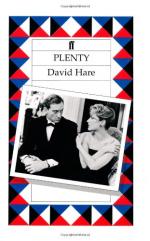|
This section contains 364 words (approx. 1 page at 400 words per page) |

|
Plenty Summary & Study Guide Description
Plenty Summary & Study Guide includes comprehensive information and analysis to help you understand the book. This study guide contains the following sections:
This detailed literature summary also contains Bibliography and a Free Quiz on Plenty by David Hare.
On April 7,1978, Plenty was performed for the first time at London's Lyttelton Theatre. Its author, David Hare, directed this production starring Kate Nelligan as the play's protagonist, Susan Traherne. Plenty is one of Hare's most successful plays and the work with which he is most closely identified. Despite being oae of the playwright's more popular works, the critical reception to Plenty was initially mixed. The play received a rather cool reception in England during its initial-production, yet met with great approval in its U.S. debut in 1980 (the play's 1985 film adaptation was also greeted more favorably in America) The work's American popularity and the reluctance of British critics to embrace Plenty are at odds with both the author and the play's pedigree. Hare is an Englishman and Plenty—like the bulk of his work—is primarily set in England and deals with distinctly British themes. Like many literary works, however, tune has shown Hare's play to be a valuable part of British (and worldwide) drama, the work gained new respect in the 1980s and 1990s—thanks largely to the successful movie adaptation.
As with the majority of his work, Hare's Plenty is noted for its well-defined characters, incisive dialogue, cinematic staging techniques, and a concern for social/political issues (Hare is an active socialist). The character of Susan is often cited as a prime example of the playwright's facility with strong female characters: in Dreams and Deconstructions: Alternative Theatre in Britain, Steve Grant noted that Traherne is Hare's "most colossal role to date." Susan is a woman conflicted by the triumphs of her past and the mundane nature of her present circumstances. Plenty does not follow a linear chronology but rather shifts back and forth through Susan's adult life. In this manner Hare illustrates not only how one's youthful dreams are rarely realized but how a character's personal life can affect the outside world. This conflict of personal versus private life is often seen as one of the play's central themes. Audiences have been attracted to Plenty for this reason as well as for the play's unique characters, unconventional structure, and its bittersweet examination of lost youth and dreams.
Read more from the Study Guide
|
This section contains 364 words (approx. 1 page at 400 words per page) |

|



